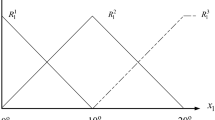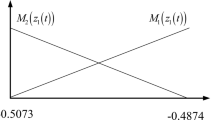Abstract
In this study, we present a Takagi–Sugeno (T–S) fuzzy model for the modeling and stability analysis of oceanic structures. We design a nonlinear fuzzy controller based on a parallel distributed compensation (PDC) scheme and reformulate the controller design problem as a linear matrix inequalities (LMI) problem as derived from the fuzzy Lyapunov theory. The robustness design technique is adopted so as to overcome the modeling errors for nonlinear time-delay systems subject to external oceanic waves. The vibration of the oceanic structure, i.e., the mechanical motion caused by the force of the waves, is discussed analytically based on fuzzy logic theory and a mathematical framework. The end result is decay in the amplitude of the surge motion affecting the time-delay tension leg platform (TLP) system. The feedback gain of the fuzzy controller needed to stabilize the TLP system can be found using the Matlab LMI toolbox. This proposed method of fuzzy control is applicable to practical TLP systems. The simulation results show that not only can the proposed method stabilize the systems but that the controller design is also simplified. The effects of the amplitude damping of the surge motion on the structural response are obvious and work as expected due to the control force.




Similar content being viewed by others
Abbreviations
- M :
-
Mass matrix of structure
- C :
-
Damping coefficient matrix of structure
- K :
-
Stiffness matrix of structure
- R n :
-
Real vector space of dimension n
- R n×m :
-
Real matrix space of dimension n × m
- A T :
-
Transpose of matrix A
- A > 0:
-
Matrix A is a positive definite matrix
- A ≥ 0:
-
Matrix A is a positive semi-definite matrix
- λ i (A):
-
i-th eigenvalue of the matrix A
References
Boyd S, Ghaoui LE, Feron E, Balakrishnan V (1994) Linear matrix inequalities in system and control theory. SIAM, Philadelphia
Chen BS, Tseng CS, Uang HJ (1999) Robustness design of nonlinear dynamic systems via fuzzy linear control. IEEE Trans Fuzzy Syst 7:571–585
Chen CW (2011) Stability analysis and robustness design of nonlinear systems: an NN-based approach. Appl Soft Comput 11(2):2735–2742
Chen CW (2006) Stability conditions of fuzzy systems and its application to structural and mechanical systems. Adv Eng Softw 37:624–629
Chen CW (2009) The stability of an oceanic structure with T-S fuzzy models. Math Comput Simul 80:402–426
Chen CW (2010) Fuzzy control of interconnected structural systems using the fuzzy Lyapunov method. J Vib Control. doi:10.1177/1077546310379625
Chen CW (2010) Application of fuzzy-model-based control to nonlinear structural systems with time delay: an LMI method. J Vib Control 16:1651–1672
Chen CW (2010) Modeling and fuzzy PDC control and its application to an oscillatory TLP structure. Math Probl Eng Open Access J. doi:10.1155/2010/120403
Chen CW, Chen PC (2010) GA-based adaptive neural network controllers for nonlinear systems. Int J Innov Comput Inf Control 6:1793–1803
Chen CW, Chen PC, Chiang WL (2010) Stabilization of adaptive neural network controllers for nonlinear structural systems using a singular perturbation approach. J Vib Control. doi:10.1177/1077546309352827
Chen CW, Chiang WL, Tsai CH (2006) Fuzzy Lyapunov method for stability conditions of nonlinear systems. Int J Artif Intell Tools 15:163–171
Chen CW, Lin CL, Tsai CH (2007) A novel delay-dependent criteria for time-delay T-S fuzzy systems using fuzzy Lyapunov method. Int J Artif Intell Tools 16:545–552
Chen CW, Shen CW, Chen CY, Jeng MJ (2010) Stability analysis of an oceanic structure using the Lyapunov method. Eng Comput 27:186–204
Chen CW, Chiang WL, Tsai CH et al (2006) Fuzzy Lyapunov method for stability conditions of nonlinear systems. Int J Artif Intell Tools 15:163–171
Chen CW, Chiang WL, Hsiao FH (2004) Stability analysis of T-S fuzzy models for nonlinear multiple time-delay interconnected systems. Math Comput Simul 66:523–537
Chen CW, Wang HL, Liu FR, Chen TH (2010) Application of project cash management and control for infrastructure. J Mar Sci Technol 18:644–651
Chen CW, Yeh K, Chiang WL, Chen CY, Wu DJ (2007) Modeling, H ∞ control and stability analysis for structural systems using Takagi-Sugeno fuzzy model. J Vib Control 13:1519–1534
Chen CW, Yeh Ken, Liu FR (2009) Adaptive fuzzy sliding mode control for seismically excited bridges with lead rubber bearing isolation. Int J Uncertain Fuzziness Knowl Based Syst 17:705–727
Chen CY, Shen CW, Chen CW, Liu KFR, Jeng MJ (2009) A stability criterion for time-delay tension leg platform systems subjected to external force. China Ocean Eng 23:49–57
Chen CW (2009) Modeling and control for nonlinear structural systems via a NN-based approach. Expert Syst Appl 36:4765–4772
Chen CW, Wang MHL, Lin JW (2009) Managing target the cash balance in construction firms using a fuzzy regression approach. Int J Uncertain Fuzziness Knowl Based Syst 17:667–684
Chen PC, Chen CW, Chiang WL, Lo DC (2011) GA-based decoupled adaptive FSMC for nonlinear systems by a singular perturbation scheme. Neural Comput Appl. doi:10.1007/s00521-011-0540-7
Chen PC, Chen CW, Chiang WL (2008) GA-based fuzzy sliding mode controller for nonlinear systems. Math Probl Eng Open Access J. doi:10.1155/2008/325859
Chen PC, Chen CW, Chiang WL, Yeh K (2009) A novel stability condition and its application to GA-based fuzzy control for nonlinear systems with uncertainty. J Mar Sci Technol 17:293–299
Chen PC, Chen CW, Chiang WL (2011) Linear matrix inequality conditions of nonlinear systems by genetic algorithm-based H ∞ adaptive fuzzy sliding mode controller. J Vib Control 17(2):163–173
Chen PC, Chen CW, Chiang WL (2009) GA-based modified adaptive fuzzy sliding mode controller for nonlinear systems. Expert Syst Appl 36:5872–5879
Chen CY, Lin JW, Lee WI, Chen CW (2010) Fuzzy control for an oceanic structure: a case study in time-delay TLP system. J Vib Control 16:147–160
Cococcioni M, Guasqui P, Lazzerini B et al (2006) Identification of Takagi-Sugeno fuzzy systems based on multi-objective genetic algorithms. Lect Note Artif Int 3849:172–177
Hsiao FH, Chen CW, Liang YW, Xu SD, Chiang WL (2005) T-S fuzzy controllers for nonlinear interconnected systems with multiple time delays. IEEE Trans Circuits Syst I Regul Pap 52:1883–1893
Hsiao FH, Chen CW, Wu YH, Chiang WL (2005) Fuzzy controllers for nonlinear interconnected TMD systems with external force. J Chin Inst Eng 28:175–181
Hsiao FH, Chiang WL, Chen CW, Xu SD, Wu SL (2005) Application and robustness design of fuzzy controller for resonant and chaotic systems with external disturbance. Int J Uncertain Fuzziness Knowl Based Syst 13:281–295
Hsiao FH, Hwang JD, Chen CW, Tsai ZR (2005) Robust stabilization of nonlinear multiple time-delay large-scale systems via decentralized fuzzy control. IEEE Trans Fuzzy Syst 13:152–163
Hsieh TY, Wang MHL, Chen CW et al (2006) A new viewpoint of S-curve regression model and its application to construction management. Int J Artif Intell Tools 15:131–142
Li X, de Souza CE (1997) Criteria for robust stability and stabilization of uncertain linear systems with state delay. Automatica 33:1657–1662
Limanond S, Si J (1998) Neural-network-based control design: an LMI approach. IEEE Trans Neural Netw 9:1422–1429
Lin ML, Chen CW (2010) Stability analysis of community and ecosystem hierarchies using the Lyapunov method. J Vib Control. doi:10.1177/1077546310385737
Lin ML, Chen CW (2010) Application of fuzzy models for the monitoring of ecologically sensitive ecosystems in a dynamic semi-arid landscape from satellite imagery. Eng Comput 27:5–19
Lin ML, Chen CW, Wang QB, Cao Y (2009) Fuzzy model-based assessment and monitoring of desertification using MODIS satellite imagery. Eng Comput 26:745–760
Lu LT, Chiang WL, Tang JP et al (2003) Active control for a benchmark building under wind excitations. J Wind Eng Ind Aerodyn 91:469–493
Lu LT, Chiang WL, Tang JP (1998) Application of model reduction and LQG/LTR robust control methodology in active structure control. J Eng Mech ASCE 124:446–454
Sugeno M, Kang GT (1986) Fuzzy modeling and control of multilayer incinerator. Fuzzy Sets Syst 18:329–346
Takagi T, Sugeno M (1985) Fuzzy identification of systems and its applications to modeling and control. IEEE Trans Syst Man Cybern 15:116–132
Tanaka K (1996) An approach to stability criteria of neural-network control systems. IEEE Trans Neural Netw 7:629–643
Tanaka K (1995) Stability and stabilization of fuzzy-neural-linear control systems. IEEE Trans Fuzzy Syst 3:438–447
Tanaka K, Wang HO (2001) Fuzzy control systems design and analysis. Wiley, New York
Tanaka K, Sugeno M (1992) Stability analysis and design of fuzzy control systems. Fuzzy Sets Syst 45:135–156
Tsai CH, Chen CW, Chiang WL, Lin ML (2008) Application of geographic information system to the allocation of disaster shelters via fuzzy models. Eng Comput Int J Comput Aided Eng Softw 25:86–100
Wang HO, Tanaka K, Griffin MF (1995) Parallel distributed compensation of nonlinear systems by Tanaka-Sugeno fuzzy model. Proc FUZZ IEEE/IFES’95 531–538
Wang H, Tanaka OK, Griffin MF (1996) An approach to fuzzy control of nonlinear systems: stability and design issues. IEEE Trans Fuzzy Syst 4:14–23
Yeh K, Chen CW (2010) Stability analysis of interconnected fuzzy systems using the fuzzy Lyapunov method. Math Probl Eng Open Access J. doi:10.1155/2010/734340
Yeh K, Chen CY, Chen CW (2008) Robustness design of time-delay fuzzy systems using fuzzy Lyapunov method. Appl Math Comput 205:568–577
Yeh K, Chiang WL, Juang DS (1996) Application of fuzzy control theory in active control of structures. Int J Uncertain Fuzziness Knowl Based Syst 4:255–274
Zadeh LA (1965) Fuzzy sets. Inf Control 8:338–353
Zhang ZY, Zhou HL, Liu SD et al (2006) An application of Takagi-Sugeno fuzzy system to the classification of cancer patients based on elemental contents in serum samples. Chemometr Intell Lab Syst 82:294–299
Acknowledgments
The author acknowledges the financial support from the National Science Council of Taiwan, R.O.C., under project number NSC 98-2221-E-366-006-MY2. The authors are also most grateful for the kind assistance of Prof. John MacIntyre, Chief-editor of Neural Computing & Applications, and the constructive suggestions of the anonymous reviewers all of which has led to the making of several corrections and suggestions that have greatly aided us in improving the presentation of this paper.
Author information
Authors and Affiliations
Corresponding author
Rights and permissions
About this article
Cite this article
Chen, CW. Modeling, control, and stability analysis for time-delay TLP systems using the fuzzy Lyapunov method. Neural Comput & Applic 20, 527–534 (2011). https://doi.org/10.1007/s00521-011-0576-8
Received:
Accepted:
Published:
Issue Date:
DOI: https://doi.org/10.1007/s00521-011-0576-8




